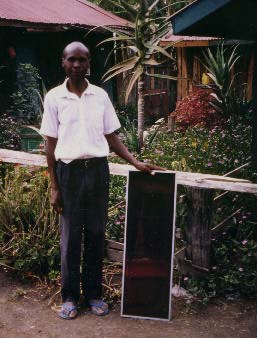|
Proof it can exist: A non-subsidized market for photovoltaics in rural Kenya
The flourishing market for photovoltaic systems in rural Kenya is the archetypal success story for renewable energy. Beginning in the mid 1980s with a major decrease in cost and increase in efficiency of photovoltaics, this market now constitutes a US$ 6 million industry in Kenya's rural sector. Before the emergence of the PV market, there was an enormous demand for electricity from the rural sector not being met by the national Electricity Company, KPLC (Kenya Power and Light Company). As the sole provider of electricity, only 3.4% of the power KPLC supplied was for rural consumers while Kenya's rural sector constituted 75% of the total population. KPLC's effective monopoly on electricity made in inefficient and unresponsive to demand. Coupled with the difficulties associated with grid extension, rural Kenyans realized the unlikelihood of electricity from the grid in the future. Thus began the search for an alternative. NGO funded projects had introduced photovoltaic technology to rural Kenya and provided empirical evidence of it's legitimacy. This became the "technological seed" that generated the demand for photovoltaic technology. In the beginning of the PV market, most of the buyers were upper-middle class households, as the price was relatively high (due to the inevitable lowering of cost described by the "experience curve" associated with any new technology). As this generated a greater demand for PV technology, large numbers of middle class rural households started to buy small PV panels for light and television, driving down the cost and creating a local industry for technicians trained in PV installation and repair. The nextphase of the burgeoning markets development was the emergence of hire and purchase agencies, which allowed Kenyans without the marginal income to afford the startup costs to purchase a system on credit, further eliminating the price barrier of the system.
In contrast to most rural electrification cases, the key factor to the emergence of the PV market was the government's hands off approach. Government subsidies would have undermined the private sectors activity and distorted the industry. The particular circumstances from which the market rose were by no means exclusive. Although short grid extensions are currently more viable due to cost, when this is not an option and the climate is appropriate, rural Kenya has proven photovoltaic technology to be a legitimate alternative. Pictures taken from: http://ist-socrates.berkeley.edu/~rael/aSikenya.html
<<back || index || next>> |

